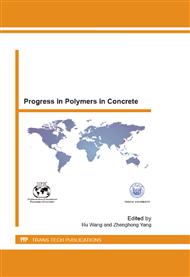p.35
p.45
p.57
p.68
p.77
p.84
p.88
p.94
p.100
Novel Core-Shell Hybrid Polymers Designed as Dual Functional Additives for Concrete
Abstract:
Novel hybrid admixtures for construction applications were prepared by layer-by-layer deposition technique. Colloidal core templates consisting of styrene/n-butylacrylate latex particles were coated with multilayers of superplasticizers commonly used in concrete. This way, core-shell particles possessing both dispersing and film-forming properties were achieved. Incorporation of the latex@dispersant hybrid additive into a cement paste results in a slow release of the superplasticizer as a result of gradual shell disintegration which instigates prolonged plastification (long ”slump life”) of the cement slurry. Once the shell has been dissolved, latex particles are released into the pore solution and can coalesce into a polymer film which improves the mechanical properties of the hardened cement. Characterization of the templates and novel additives was performed by means of zeta potential measurement, dynamic light scattering and electron microscopy. Our method allows to synthesize multifunctional additives with time-controlled release effect.
Info:
Periodical:
Pages:
77-83
Citation:
Online since:
April 2013
Authors:
Keywords:
Price:
Сopyright:
© 2013 Trans Tech Publications Ltd. All Rights Reserved
Share:
Citation:


